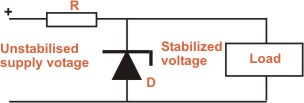|
|
| Zener Diode |
|
|
A Zener diode is a type of diode that permits current in the forward direction like a normal diode, but also in the reverse direction if the voltage is larger than the breakdown voltage known as Zener knee voltage or Zener voltage. |
|
|
The device was named after Clarence Zener, who discovered this electrical property. |
|
 |
|
|
It has two main applications :
|
|
As a reference source, where the voltage across it is compared with another voltage. |
|
As a voltage regulator, smoothing out any voltages variations occurring in the supply voltage across the load.
|
|
|
When being used a voltage regulator, if the voltage across the load tries to rise then the Zener takes more current. |
|
|
The increase in current through the resistor causes an increase in voltage dropped across the resistor.
This increase in voltage across the resistor causes the voltage across the load to remain at its correct value.
|
|
|
In a similar manner, if the voltage across the load tries to fall, then the Zener takes less current.
The current through the resistor and the voltage across the resistor both fall.
The voltage across the load remains at its correct value.
|
|
|
Since the voltage dropped across a Zener Diode is a known and fixed value, Zener diodes are typically used to regulate the voltage in electric circuits.
|
|